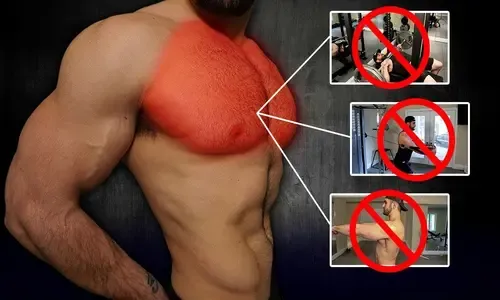If you want to build a bigger chest, incorporating chest exercises into your workout routine is essential. One of the most effective exercises for chest development is the chest fly. However, if you don't perform this exercise correctly, you may end up working other muscles like your shoulders instead of your chest. In this article, we will discuss the five most common chest training mistakes that are stopping you from making gains. By understanding and correcting these mistakes, you can maximize your chest growth and achieve the results you desire.
Mistake #1: Neglecting Proper Form
One of the biggest mistakes people make when performing chest flys is neglecting proper form. Many individuals focus on the weight they are lifting rather than the quality of their technique. This can lead to ineffective chest activation and potential injury. To perform chest flys correctly, it is important to pay attention to your arm positioning.
Dumbbell Chest Flys
When performing dumbbell chest flys, a common mistake is extending your arms too straight. While this may increase tension on your chest, it also brings your biceps into play, making them the limiting factor instead of your chest. Instead, aim for a slight bend in your elbows at the bottom position to keep the focus on your chest.
Cable Chest Flys
With cable chest flys, the direction of the cable determines the force placement on your body. If the cable angle is not aligned with your arms, it can shift tension away from your chest and onto other muscles like your lats or front delts. To maximize chest activation, ensure that the direction of the cable is aligned with your arms throughout the movement.
Machine Chest Flys (Pec Deck)
Similar to cable chest flys, the line of force is crucial in machine chest flys. While you can't adjust the line of force with machines like the pec deck, you can focus on keeping your elbows up to maintain the proper alignment between your hands and shoulders. This will help engage your chest muscles effectively.
Mistake #2: Allowing Shoulders to Take Over
Another common mistake during chest training is allowing your shoulders to take over the movement, leading to limited chest activation. This can happen when your shoulders round forward at the end of the movement. To prevent this, focus on bringing your shoulders down and away from your ears, while keeping your chest up and out. By doing so, you can ensure that the tension is placed on your chest rather than your shoulders.
Mistake #3: Neglecting Upper and Lower Chest Activation
Many individuals focus solely on the mid-chest during their chest training, neglecting the importance of targeting the upper and lower chest. This can lead to an imbalanced chest development. To achieve a well-rounded and balanced chest, it is crucial to adjust your chest fly setup and target different areas of your chest.
Targeting the Lower Chest
To target the lower chest, you can adjust the pulleys higher for cable chest flys and perform high to low flys. Ensure that your forearms move in line with the direction of the cables for proper form and maximum activation.
Targeting the Upper Chest
For targeting the upper chest, incorporate a slight incline bench setup for bench press or dumbbell chest flys. This slight incline will emphasize the upper chest and contribute to a more balanced chest development.
Mistake #4: Overreliance on Dumbbell Chest Flys
While dumbbell chest flys are a popular exercise, overreliance on this movement can limit your chest development. Dumbbell flys mainly challenge your chest at the bottom position, and as you move towards the top, the tension decreases. This is why studies comparing dumbbell flys to other chest exercises like the bench press show limited chest activation.
To maximize growth, it is important to challenge your chest throughout the entire range of motion. This can be achieved through properly executed cable chest flys or machine pec deck exercises. These exercises allow for consistent tension on the chest, especially in the end position when your arms are brought together.
Mistake #5: Lack of Variation in Chest Exercises
The final mistake to avoid is a lack of variation in your chest exercises. While certain exercises like the bench press and dumbbell press target the mid-chest effectively, incorporating different variations of chest flys can provide a more comprehensive and balanced chest workout.
By using different equipment and angles, you can target specific areas of your chest, such as the upper and lower chest. This variation not only promotes overall chest development but also helps to avoid plateaus in your training progress.
In conclusion, by avoiding these five common chest training mistakes, you can optimize your chest workout and achieve greater gains. Focus on maintaining proper form, preventing shoulder takeover, targeting the entire chest, and incorporating variation into your routine. By doing so, you will build a stronger, more muscular chest and reach your fitness goals. Remember, consistency and proper technique are key to making gains in any muscle group, including your chest.

